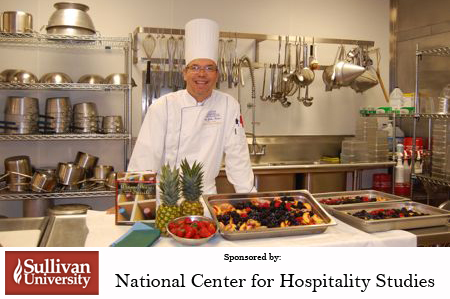Let me be brutally honest and state for the record that I am not a fan of pumpkin. I know that statement will probably anger pumpkin producers as well as pumpkin lovers (like my wife!), pumpkin bread aficionados and even some Halloween fans.
I mean they and their pumpkins no disrespect. I’m not a fan primarily because I rarely have a pumpkin based dish which truly conveys the flavor of the vegetable to the plate. Most often for me it is a matter of too much spice, too much sugar or texture issues that range from spongey to stringy.
There are notable exceptions; our pumpkin cake on the new Sage Rabbit dessert menu, with its light texture and deep pumpkin color and flavor with just the right amount of spice. It starts with a slow roasted pie pumpkin, plenty of scooping and straining the stringiness out and a light hand with traditional spices to allow the flavor to come through.
Pumpkin ravioli with a sage cream in a little Italian place in New York City many years ago gave me hope that I was on to something, but alas it has been a veritable pumpkin waste land in between.
I blame myself mostly. Have I really researched the best uses of pumpkin? Is a spiced puree baked into a pie shell and topped with whipped cream really the apex of all you could wish for? Probably not, and it’s up to me to delve deeper into the nooks and crannies where inventive recipes lie.
Pepita (pumpkin seed) crusted sea bass with citrus beurre blanc actually conveys the grassiness of pumpkin through the toasted seeds. Paired with the citrus bite and sweetness of the beurre blanc, the richness of the bass, and the saltiness of the seed makes for an interesting blend of untraditional flavors.
Curried pumpkin, either in a soup or as part of a batch of vegetables, makes use of the pumpkins ability when roasted to have a pronounced nuttiness. Add in some toasted ground pumpkin seed to thicken the soup and that accentuates the nuttiness. Pumpkins inherent but unpronounced sweetness helps to cut the edge of most hot curries and the bulk of the pumpkin, mush like winter squash stands up well to the roasting process.
Finally there is a “cooling “quality to pumpkins and winter squashes that allows us the spice range from curry to Caribbean, Latin America to Szechwan, China.
Ginger and pumpkin, coconut and pumpkin, coconut, ginger curried pumpkin soup brings another type of sweetness to the pumpkin and adds back in some of the traditional pumpkin pie spices that we recognize.
Jerk spice will create the same spice buzz with the addition of some acid and heat. Spicing and roasting the pumpkin over a wood fire adds a layer of Halloween madness that sends our taste buds in a completely weird and different direction. Caramelization is a key method to extract sweetness, careful choice of pumpkin (you want small pie pumpkins alleviates some of the texture issues (stringiness). When faced with a mass of sinew inside the pumpkin its best just too scape that layer down to the point that you hit clear, smooth meat and start from there.
So the next time you’re carving pumpkins, consider getting an extra one to experiment with. You may find, like I did, that they are not as scary as they seem.
Masala mix for curry
The following spices are better purchased in seed form, toasted and ground. If that is not possible try and buy spices from a reputable source as some dry spices have been on the shelves too long. If using seeds then you need to process enough to:
1 tablespoon black pepper
1 tablespoon coriander
1 tablespoon cumin
1 tablespoon fennel
1 tablespoon cardamom
½ tablespoon clove
½ tablespoon turmericIf purchased as seed, carefully toast amounts in a dry pan until they are aromatic but not burned. You will need to process enough to yield the recipe’s stated amounts.
Once toasted and ground you can store in an airtight container for several weeks. This spice can be applied dry, with oil or clarified butter or can be added to sweated, onion, garlic and ginger into a liquid curry. Once the spice and aromatics have mellowed add a bit of coconut milk, the cubed raw pumpkin and simmer covered until the pumpkin is tender.
John Foster is an executive chef who heads the culinary program at Sullivan University’s Lexington campus. A New York native, Foster has been active in the Lexington culinary scene and a promoter of local and seasonal foods for more than 20 years. The French Culinary Institute-trained chef has been the executive chef of his former restaurant, Harvest, and now his Chevy Chase eatery, The Sage Rabbit, in Lexington.
To read more from Chef John Foster, including his recipes, click here.























